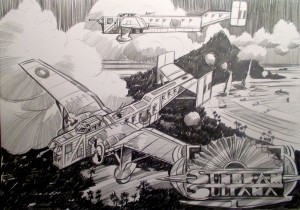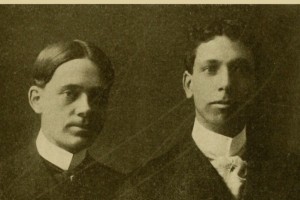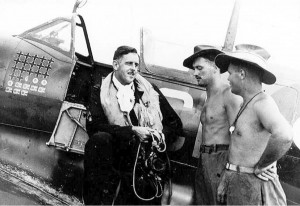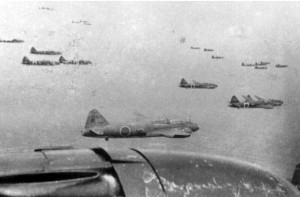The Sunbeam Sultana
Dear Reader, another instalment from the archive, in which we give timely praise to the “cardboard wonder”, our very own “Biscuit Bomber”, the ‘Sunbeam Sultana’.

The unusually striking appearance of the Sunbeam Sultana. Note the open gun ports and distinctive “packing case” fuselage.
Ingenuity has always been a byword for Australian technical knowhow. Invention is second nature to a country steeped in the vicissitudes of climate and variability. The Sunbeam Sultana, was originally developed as the CAF Cardboard in response to a competition seeking a low cost, high volume manufacture, economical transport and logistics aircraft. Implicit in the brief was the requirement that manufacture should not require highly developed skills. The initial aircraft prototype, (‘The Picola Prune”) manufactured at the Sunraysia Dried Fruit and Grape Processing Company plants stone fruit and jam hydration plant in Robinvale, performed regularly at the Mildura Field Days in early 1941. Impressed by the ingenuity, reliability and craftsmanship exhibited in a test flight over Canberra the judges duly awarded it first prize.
Designed originally as a stop gap replacement to the worthy but slow DC3 Biscuit Bomber. It outperformed the Wapiti, Wackett and Wirraway in offering fast, lightweight transport, with performance, so exhilarating, the aircraft design establishment nicknamed it the ‘Cardboard Comet’. Nothing encapsulated this capacity for improvisation more then the ‘Sunbeam Sultana’. Conceived, developed and refined by a locals who knew their business the Riverland Dried Fruit Packing Case Company, the Sultana proved the old adage; ‘where there is a will, there is a way,’. And a more willing product could not have been found. Developed over a considerable period of time, the brain child and Des and Wes Dunt, of Mildura. Inventors of the ‘Dunt Dart’, the pioneering delivery van constructed entirely of plywood.

Des and Wes Dunt. “The Dunt Brothers”. Pioneering aircraft designers. Photo taken c. 1936. Generously donated by the Rt. Hon. Christopher Pyne, Minister for Science and whatnot. From his personal collection.
The Sultana was a cardboard bonded and laminated structure, bonded to an interior framework of reconfigured packing cases. Its secret in durability was the patented waxing of the card itself which gave it durability and protection from its nemesis ‘moisture’. This ultra lightweight aircraft was then powered by two Bristol Mercury engines. These gave the aircraft exhilarating power and scintillating performance. The Sultana was an extraordinary aircraft, Due to its light weight It had breathtaking performance, being able to climb to 20,000 feet in under five minutes, Capable of delivering a payload of bombs, (some 2000 k) over a distance of 2000 miles an endurance of 24 hrs, and formidable punch in the form of 4 20mm hispano suiza cannon. Incredibly due to its lightweight construction testing proved that in addition to the forward defensive armament, the Sultana could be equipped with a broadside of Lee Enfield .303’s firing through open gunports on either side of the fuselage. The cardboard was described by none other than Clive ‘Killer’ Caldwell as; ‘imagine being wacked over the head with a rolled up newspaper and a stick of dynamite, any way you use it, it’ll hurt’.

Caldwell. Instructing aircraftsmen on how to utilise rubber hose in defence of the Northen Territory. Hose generously donated by the Rt. Hon. Christopher Pyne. From his personal collection.
And hurt it did. Destroying swarms of japanese aircraft with its capacity to deliver. The Sultana could absorb any fire without damage. With self sealing tanks, and its lightweight structure, ordnance just simply passed through it. It was easy to repair, (Masking Tape, and a Stanley Knife), thus enabling relatively unskilled maintenance crew to get them back in flying condition. As the slogan went, ‘Ingenuity it’s own reward, build another cardboard’. In one celebrated engagement, a squadron of Sultanas was intercepted by Betty’s’ and they proved no match, beaten and bashed by the cardboard cohorts. Stimulated by their success in the defense of Darwin and Broome, the Sultana was consigned to Port Moresby readied for an attack on Milne Bay with a mixed escort of Kitty Hawks and Beaufort’s.

Betty Bombers of No. 8 Fukushima Squadron fly headlong into a Sultana Attack.
Scrambled for attack in the early night, the Sultanas gathered above the Owen Stanley’s and prepared to descend upon the landing barges, with the intention of strafing the beaches. Just at that moment, a monsoonal rain squall (which are quite frequent in this area) un-leashed it tropical fury. Within minutes, the Cardboards,were soaked and in an instant their superb aerodynamic qualities were rendered soggy. With drooping wings, sagging ailerons, and soppy spinner the cardboards ‘sludged’ into the hillsides, lost beneath the cloud cover. The subsequent investigation revealed, ‘waterlogging and warpage’. In the words of the enquiry, the cardboard though formidable was not designed for tropical climes an oversight not foreseen in the design offices of the dry interior. The protective waxing surface had melted over a period of weeks in the tropical heat, and stress fractures around the cockpit indicated that the waxing had been scraped by pilots as a substitute for brilliantine. Sadly, what promised to be a biscuit bomber bombed. A very soggy biscuit indeed.
Sunbeam Sultana Specifications
Crew: 2. Range: 2000 miles
Powerplant: Two Bristol Mercury Radial Engines. Max speed: 320 mph @ 30,000 feet
Armament 4 x 20 mm Hispano Suiza cannons. 2 x 250 lb bombs. 2 x 250 lb depth charges.
Operators: RAAF
